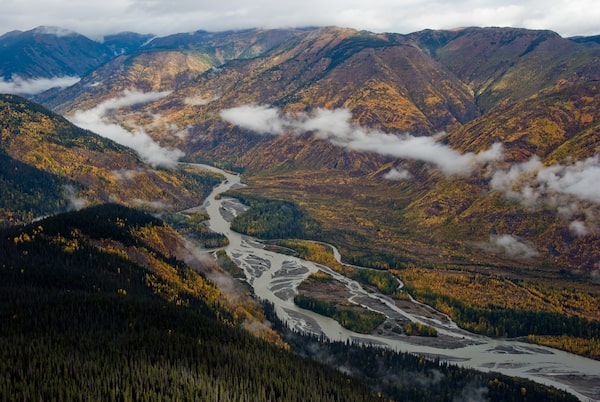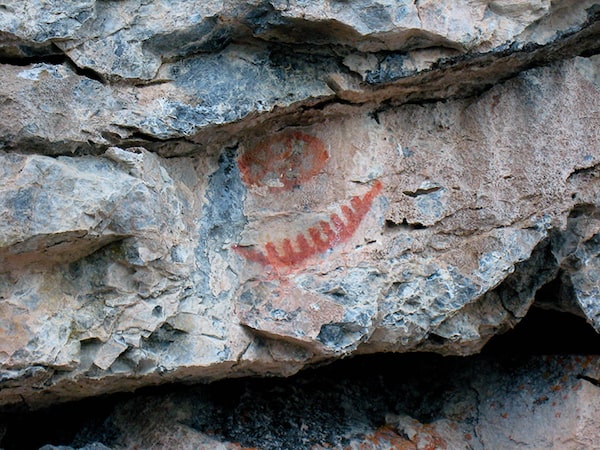
The Yellow Bluff area on the lower Taku River in B.C. The Taku River Tlingit have declared that 60 per cent of the Taku River system will be preserved as an Indigenous Protected and Conserved Area.Bryan Evans/Handout
British Columbia’s Taku River system is the largest intact watershed on the Pacific coast of North America. A decision this week by the Taku River Tlingit First Nation increases the likelihood that this rare, rich ecological refuge will remain that way.
Located in the far northwest corner of the province, the 1.8-million-hectare Taku watershed is one of only a few regions in B.C. that bear no major scars from human development.
The Taku River Tlingit have declared that 60 per cent of the area will be preserved as what is known as an “Indigenous Protected and Conserved Area,” including all of its salmon-bearing rivers and streams. The balance will be treated as “specially managed landscapes,” which will include zones with high mineral potential where the nation says it is willing to consider “respectful, clean mineral extraction.”
While a First Nation can unilaterally declare an IPCA, approval from other levels of government generally is needed to enforce land-use changes. The federal government has promoted the use of the mechanism as a way of achieving its biodiversity and climate targets in collaboration with Indigenous peoples.
There is just one road into Atlin, B.C., a small, remote community within the watershed where the First Nation of roughly 450 members is based. Aside from that and an abandoned mine, the area is an unbroken landscape of wetlands and mountains, coastal temperate and inland boreal forests. It supports grizzly bears, woodland caribou, stone sheep, moose, wolf, mountain goats and wolverines. The wild, glacier-fed rivers are home to five species of salmon.
“It sustains our way of life,” said Charmaine Thom, the elected spokesperson for the Taku River Tlingit. “It is who we are.”

The Inklin River, a major tributary of the Taku, flows near the confluence with Sutlahine River. Covering a 1.8-million-hectare area, the Taku river system is the largest intact watershed on the Pacific coast of North America.Handout
Biologically and ecologically intact landscapes that are mostly free of human disturbance are increasingly recognized as important to mitigating the effects of climate change and for maintaining biodiversity.
B.C. has an outsized role to play in preserving these wildernesses. The province is home to one-quarter of the world’s rare coastal temperate rain forest. And Canada’s boreal forests are one of the last significant places on Earth that have been largely unaltered by industrial development.
Across Canada, researchers have said one in five species they have assessed are at risk of extinction. The Taku River watershed offers a haven for plants and animals that are struggling to survive in more developed regions.
The governments of Canada and British Columbia have said in statements that they recognize the importance of Indigenous leadership in nature conservation and protection. Both have promised to protect 30 per cent of the land under their purview by the year 2030.
B.C. has roughly 18.5 million hectares of protected and conserved land, which is about 20 per cent of the province’s total land area. Adding the Taku River watershed would be a substantial step toward meeting the province’s target.
Nathan Cullen, B.C.’s Minister of Water, Land and Resource Stewardship, said in a statement that his government is committed to Indigenous-led land stewardship. But he said the Taku River Tlingit declaration will need to be discussed in a government-to-government forum.
“The province has a responsibility to respectfully work with other First Nations that overlap the proposed IPCA and with communities and stakeholders that may be impacted,” he added.

A Tlingit painting on rock outcropping near the Taku River.Bryan Evans/Handout
The Taku River Tlingit’s declaration is a result of decades of work, Ms. Thom said. She believes there is political will in the federal and provincial governments to make the protected areas stick, because of the need to move forward on biodiversity and climate action commitments.
“We are aligning ourselves with their goals,” said Ms. Thom, who also uses her traditional name, Jìnìk. “It’s a special and untouched ecosystem that needs to stay intact. We have always known that. But now we’re asking for recognition to uphold our declaration.”
The declaration also serves as notice to neighbouring First Nations. In October, the Tahltan, Kaska and Taku River Tlingit signed an agreement to work together on common goals, which could provide an avenue for resolving any potential conflicts.
Ms. Thom said her community is not opposed to mining. At the same time, it is not throwing the door open wide. There are currently two exploratory mining projects that lie within the area designated as a specially managed landscape.
“We’re not saying there won’t be economic development. If it aligns with our values, we would look at applications for a mine or other activity. Who can say what will happen in 20 years, if they can extract without harming the land?”
The Tlingit nation’s skepticism of resource development can be traced to the abandoned Tulsequah Chief mine, which is in the watershed. The underground copper, lead and zinc mine has been leaking untreated acid mine drainage into the Tulsequah River since the original owner left in 1957.
“These are the things we don’t want to see happen,” Ms. Thom said.
Lawmakers in Alaska have raised concerns about the potential effects of abandoned, active and future mines on shared waterways in the region, citing B.C.’s failure to clean up the Tulsequah Chief mine site.
William Patric, executive director of Rivers Without Borders, a conservationist group, said the Tulsequah Chief mine is an unresolved problem in an otherwise pristine watershed.
“There are so many superlatives for the Taku that you hardly know where to start. It’s incredibly wild, spectacular,” he said. “The conservation values are off the charts.”
But he said the provincial government has been slow to develop a remediation plan that was promised eight years ago. “To make the Taku not only intact, but once again truly pristine, they need to deal with the Tulsequah Chief mine,” he said.
The B.C. government produced a “conceptual closure and reclamation plan” in 2020, but has only completed interim work since.
 Justine Hunter
Justine Hunter